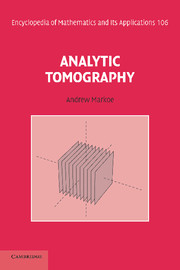Book contents
3 - The k-Plane Transform, the Radon–John Transform
Published online by Cambridge University Press: 24 October 2009
Summary
Introduction
Let us define a k plane to be any translation of a k-dimensional subspace of ℝn. Therefore, a k plane has the form η + x, where η is a k-dimensional subspace and x ∈ ℝn. Note that a hyperplane is therefore an (n – 1) plane.
The Radon transform can be generalized so that the integration is performed on k planes instead of hyperplanes. The related transform is called a k-dimensional Radon transform or a k-plane transform. Some authors use the term Radon–John transform. We use the terms synonymously, and in this chapter we develop the theory of these transforms.
The main part of this chapter begins in section 3.3 with an investigation of the set of all k-dimensional linear subspaces of ℝn. This set is called the Grassmannian and is denoted by Gk,n. Grassmannians are not only sets, but they are also manifolds and measure spaces. We do not require the manifold structure, but we do need to know how to define a suitable measure on Grassmannians. This is done by introducing homogeneous spaces and Haar measure.
Once we have Grassmannians, it is easy to describe the set of all k planes and integration on k planes. This leads to the definition of the k-plane transform and its adjoint. We study the basic properties of the k-plane transform in sections 3.4 and 3.5.
An inversion formula for the k-plane transform is of great interest. We provide four main approaches to the inversion of the k-plane transform.
- Type
- Chapter
- Information
- Analytic Tomography , pp. 127 - 237Publisher: Cambridge University PressPrint publication year: 2006



